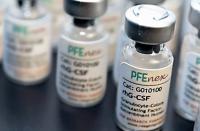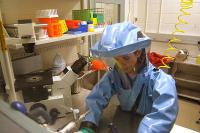-
HHS in strategic alliance to accelerate new antibiotic development
Multiple drugs to combat bioterrorism threats and other life-threatening bacterial infections will be developed under a public-private partnership agreement between the U.S. Department of Health and Human Services’ Office of the Assistant Secretary for Preparedness and Response (APSR) and AstraZeneca, a global biopharmaceutical company. The partnership will also stimulates pipeline of drugs to treat multi-drug resistant bacterial infections. CDC has estimated that in the U.S. antibiotic-resistant bacteria are responsible for two million infections and 23,000 deaths annually with an estimated annual economic burden of $35 billion on the healthcare system.
-
-
Pfenex awarded contract valued at up to $143.5 million to develop anthrax vaccine

San Diego, California-based Pfenex Inc. the other day announced it has signed a five year, cost plus fixed fee contract valued at up to $143.5 million with the Biomedical Advanced Research and Development Authority (BARDA) of the Department of Health and Human Services (HHS), for the advanced development of Px563L, a mutant recombinant protective antigen anthrax vaccine. The company says the U.S. government is looking to have a stockpile of seventy-five million doses.
-
-
Single dose Ebola vaccine is safe and effective in monkeys against outbreak strain

National Institutes of Health (NIH) scientists report that a single dose of an experimental Ebola virus (EBOV) vaccine — VSV-EBOV — completely protects cynomolgus macaques against the current EBOV outbreak strain, EBOV-Makona, when given at least seven days before exposure, and partially protects them if given three days prior. The scientists also observed that the experimental VSV-EBOV vaccine appears to provide initial protection by triggering innate virus-fighting host responses; these responses partially protected animals challenged with EBOV-Makona within a week after vaccination.
-
-
State immunization laws should eliminate non-medical exemptions: Internists
Support for eliminating existing exemptions, except for medical reasons, from immunization laws was among the policy recommendations adopted last weekend at the summer meeting of the Board of Regents of the American College of Physicians (ACP). “Allowing exemptions based on non-medical reasons poses a risk both to the unvaccinated person and to public health,” said Wayne J. Riley, M.D., president of ACP. “Intentionally unvaccinated individuals can pose a danger to the public, especially to individuals who cannot be vaccinated for medical reasons.”
-
-
California's strict vaccine bill would not allow vaccination waiver
Last Thursday, the California State Assembly passed SB227, an amendment to the current vaccine bill which would eliminate a waiver for parents to opt out of having their children vaccinated. The proposal passed on a 46-31 vote and is now going back to the Senate this week to confirm the amendments.Under SB277, students who are not vaccinated would have to be homeschooled or participate in off-campus study programs.
-
-
California vaccine bill on hold as opposing parents threaten to keep their children out of school
California Senate Bill 277, which would require parents in California to vaccinate their children as a condition for enrollmentin either public or private schools, is facing opposition, after parents and lawmakers expressed their concerns that some children might be denied an education.
-
-
Scientists: Global pandemic of fake, sub-standard medicines poses dire risk
Poor quality medicines are a real and urgent threat that could undermine decades of successful efforts to combat HIV/AIDS, malaria, and tuberculosis, according to the editors of a collection of journal articles published yesterday. Scientists report up to 41 percent of specimens failed to meet quality standards in global studies of about 17,000 drug samples. Among the collection is an article describing the discovery of falsified and substandard malaria drugs that caused an estimated 122,350 deaths in African children in 2013. Other studies identified poor quality antibiotics, which may harm health and increase antimicrobial resistance.
-
-
A durable vaccine for Ebola
African apes serve as a main source of ebolavirus transmission into the human population. As a consequence, the prevention of ebolavirus infection in African apes could reduce the incidence of future human ebolavirus outbreaks. A new study shows the durability of a novel “disseminating” cytomegalovirus (CMV)-based Ebola virus (Zaire ebolavirus; EBOV) vaccine strategy that may eventually have the potential to reduce ebolavirus infection in wild African ape species. The innovative approach may overcome the major hurdle to achieving high vaccine coverage of these animals. They live in of some of the most remote, inaccessible regions of the world which makes conventional, individual vaccination near impossible.
-
-
Protecting crops from radiation-contaminated soil
Almost four years after the accident at the Fukushima Daiichi Nuclear Power Plant in Japan, farmland remains contaminated with higher-than-natural levels of radiocesium in some regions of Japan, with cesium-134 and cesium-137 being the most troublesome because of the slow rate at which they decay. In a just-published study, scientists have identified a chemical compound that prevents plants from taking up cesium, thus protecting them — and us — from its harmful effects.
-
-
When parents hesitate about vaccines, what should health-care providers say?
In recent years, the United States has witnessed multiple outbreaks of vaccine-preventable illnesses, including pertussis (whooping cough) and measles. In the same time frame, vaccine refusal rates have gone up, and an increasing number of parents are requesting modified vaccine schedules that differ from the one recommended by the American Academy of Pediatrics (AAP). Although research overwhelmingly supports the safety and effectiveness of vaccines and indicates that the risk of negative side effects from childhood vaccines is extremely small, many parents still have concerns about vaccine safety. More research is needed to determine which interventions and ways of communicating information about vaccination are most effective at reducing parents’ vaccine hesitancy and refusal. What is clear from existing research is that respectful, tailored communications and recommendations to immunize coming directly from the health-care provider are associated with increased vaccination uptake.
-
-
Asian herb holds promise as treatment for Ebola virus disease
New research that focuses on the mechanism by which Ebola virus infects a cell and the discovery of a promising drug therapy candidate. A small molecule called Tetrandrine derived from an Asian herb has shown to be a potent small molecule inhibiting infection of human white blood cells in vitro or petri dish experiments and prevented Ebola virus disease in mice.
-
-
Measles outbreak sparks bid to strengthen California vaccine law
State lawmakers in California introduced legislation Wednesday that would require children to be fully vaccinated before going to school, a response to a measles outbreak that started in Southern California and has reached 107 cases in fourteen states. California is one of nineteen states that allow parents to enroll their children in school unvaccinated through a “personal belief exemption” to public health laws. The outbreak of measles that began in December in Anaheim’s Disneyland amusement park has spread more quickly in communities where many parents claim the exemption.
-
-
Measles outbreak raises questions about vaccination exemptions
The recent measles outbreak has, again, brought to the surface an issue which refuses to go away: the alleged connection between vaccination and autism. The qualifier “alleged” should not, in truth, be used — “discredited alleged” should be used instead — because science has conclusively and indisputably shown that there is no such connection. Still, in what the Wall Street Journal calls “The not-so-great measles vaccine debate of 2015,” lawmakers, healthcare officials, and parent groups are again debating whether states should make it easier or more difficult for parents to exempt their children from vaccination.
-
-
Speeding up Ebola drug production
Researchers at the University of California, Davis, will explore ways to speed production of the Ebola drug Zmapp with a $200,000 rapid-response grant from the National Science Foundation. Zmapp is a cocktail of antibodies produced in and extracted from whole tobacco plants. The UC Davis team, including plant scientists, molecular biologists and chemical engineers, will attempt to produce the antibodies from plant cells grown in bioreactors instead of in whole plants.
-
-
A combination ricin/anthrax vaccine shows promise
Soligenix, Inc. last month announced the publication of data demonstrating that the combination of RiVax and VeloThrax induces protective immunity to both ricin toxin and anthrax toxin exposure. RiVax is the company’s candidate vaccine for the prevention of exposure to ricin toxin using an antigen which is completely devoid of the toxic activity of ricin. VeloThrax is the company’s candidate vaccine which employs a derivative of recombinant protective antigen, termed Dominant Negative Inhibitor (DNI), which is a candidate for inclusion in a next generation anthrax vaccine.
-
More headlines
The long view
A Shining Star in a Contentious Legacy: Could Marty Makary Be the Saving Grace of a Divisive Presidency?
While much of the Trump administration has sparked controversy, the FDA’s consumer-first reforms may be remembered as its brightest legacy. From AI-driven drug reviews to bans on artificial dyes, the FDA’s agenda resonates with the public in ways few Trump-era policies have.
